

The Ultimate Guide to the Multi-Tenant Architecture






Multi-tenant architecture is important because it supports the shared use of a single system while keeping data separate. It helps teams deliver software at scale with lower cost and smoother growth across different customer groups.
Multi-tenant architecture allows many groups to use one application while keeping their data separate through logical controls. Each group sees only its own data, while the system manages all groups together in a safe, organized manner.
The rise of software delivered through the cloud has increased the need for efficient delivery. Many teams want lower cost, smooth scaling, and easy onboarding. Multi-tenant models support these goals by reducing setup effort and simplifying growth.
This blog explains the main data patterns, how they work, and the key benefits, and provides a clear guide to help you decide whether multi-tenant architecture suits your product.
Multi-tenant architecture is a design approach where a single software platform serves multiple clients, or “tenants,” who share the same infrastructure but have their data and configurations securely isolated. Instead of each company building and maintaining its infrastructure, multiple clients (tenants) can use the same software platform, sharing resources while keeping their data and operations separate.
This approach significantly reduces infrastructure costs, as the software provider only needs to maintain a single application, which many clients then use. It’s a scalable, cost-efficient solution for businesses looking to enhance digital capabilities without managing complex back-end systems.
While multi-tenant architecture provides a dedicated application instance for each client, single-tenant architecture offers more control and customization. However, it comes with higher costs and maintenance duties. Companies must maintain separate infrastructures with single-tenant systems, leading to higher resource consumption and more complex updates.
Now that we’ve clarified multi-tenant architecture let’s explore how it works and why businesses increasingly opt for containerized services to power it.
These common data patterns show how to organize tenant data safely while keeping the application easy to manage and scale.
In this model, each tenant shares a single database and a single schema. A column marks which data belongs to each group. It offers a lower cost and a simple setup. But it reduces isolation, increases risk during mistakes, and makes managing large data loads across many groups harder.
Here, one database is shared, but each group has its own schema. It offers better data separation and easier analysis per group. It increases safety without adding high cost. But managing many schemas takes effort and may slow delivery if the number of groups grows very fast.
Each group gets its own database. It offers strong separation, easier compliance, and more precise control. It supports high security needs. But the cost increases with each group, and management becomes heavier. This pattern suits large or sensitive groups but may be too heavy for small ones.
Select the pattern based on group size, data risk, and customization needs. Large or sensitive groups may need separate databases. Medium groups may fit well with separate schemas. Small groups or cost-focused products may choose a shared schema. Think about growth, support limits, and data rules before deciding.
Multi-tenant models help teams reduce effort, improve speed, and deliver consistent experiences at scale.
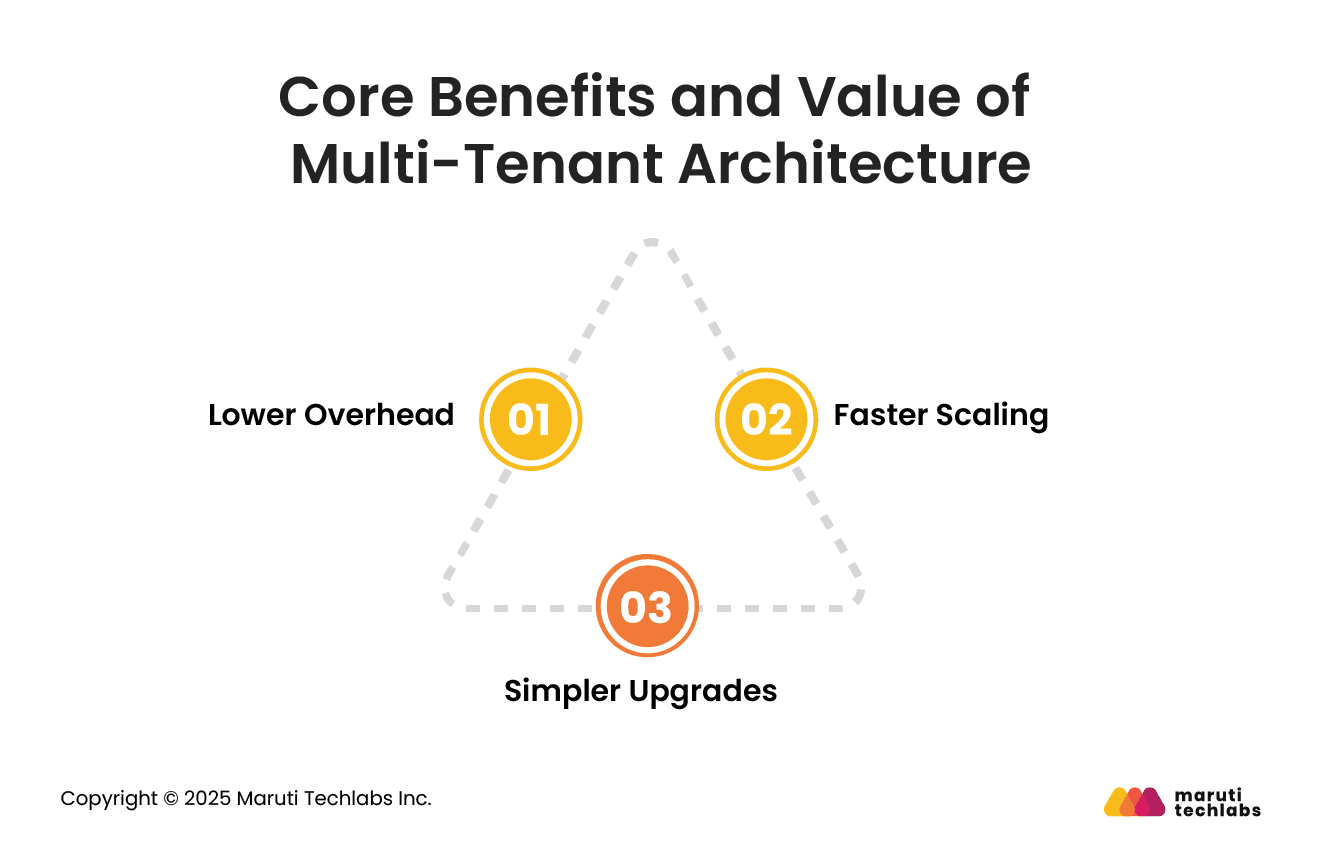
Shared systems reduce the cost of servers, storage, and support. Teams spend less on setup and ongoing care. This allows more focus on product quality and customer service rather than managing separate environments for every group.
New groups can join quickly without installing anything new. The system grows smoothly with rising demand. This supports quick entry into new markets and lets teams focus on features rather than heavy setup work.
With a single codebase for all groups, teams can fix issues and add features in one place. Updates reach every group at once. This reduces effort, avoids confusion, and keeps the product steady for all users.
Multi-tenancy is like a high-rise where tenants have private units but share common infrastructure like elevators. In software, it refers to different models for sharing applications and data.
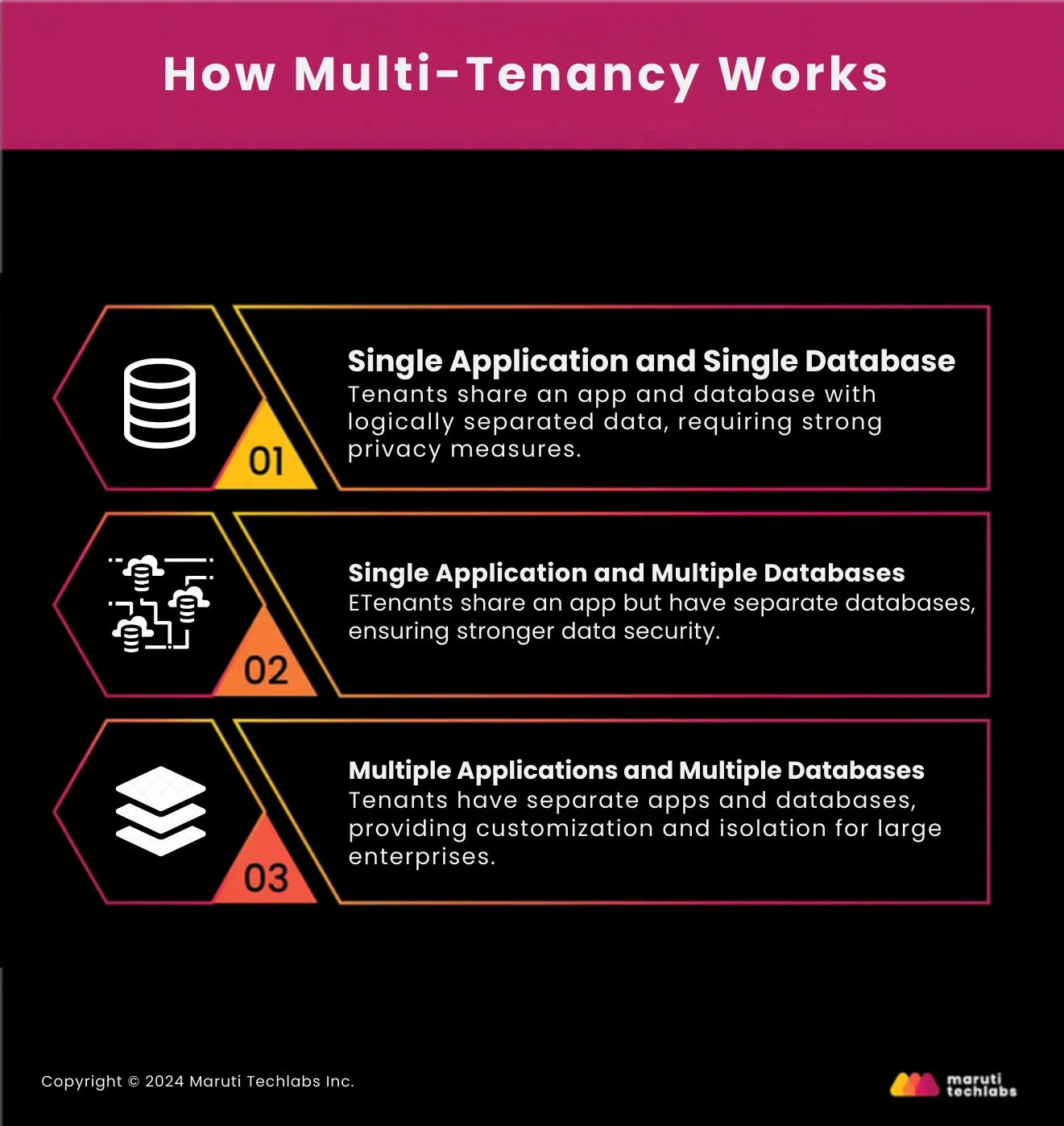
Let’s look at three main approaches:
In this model, multiple tenants share the same application and a single database. Each tenant’s data is stored in the same database but is segregated logically. This setup is efficient and cost-effective but requires strong data isolation measures to ensure privacy.
Here, tenants use the same application but have a separate database. This model offers more data security since each tenant's information is stored separately. It's ideal for businesses that require higher data protection while still sharing the core application.
In this setup, tenants have their applications and databases. It’s the most resource-intensive model but provides full customization and isolation. Large enterprises with particular needs or industries with strict regulations may prefer this model.
Considering these different approaches, let’s move on to the advantages of multi-tenant architecture, mainly when supported by containerized services.
Picture a smart office building where tenants share utilities and services but can personalize their spaces. Multi-tenant architecture operates on a similar principle, offering flexibility and efficiency while managing costs.
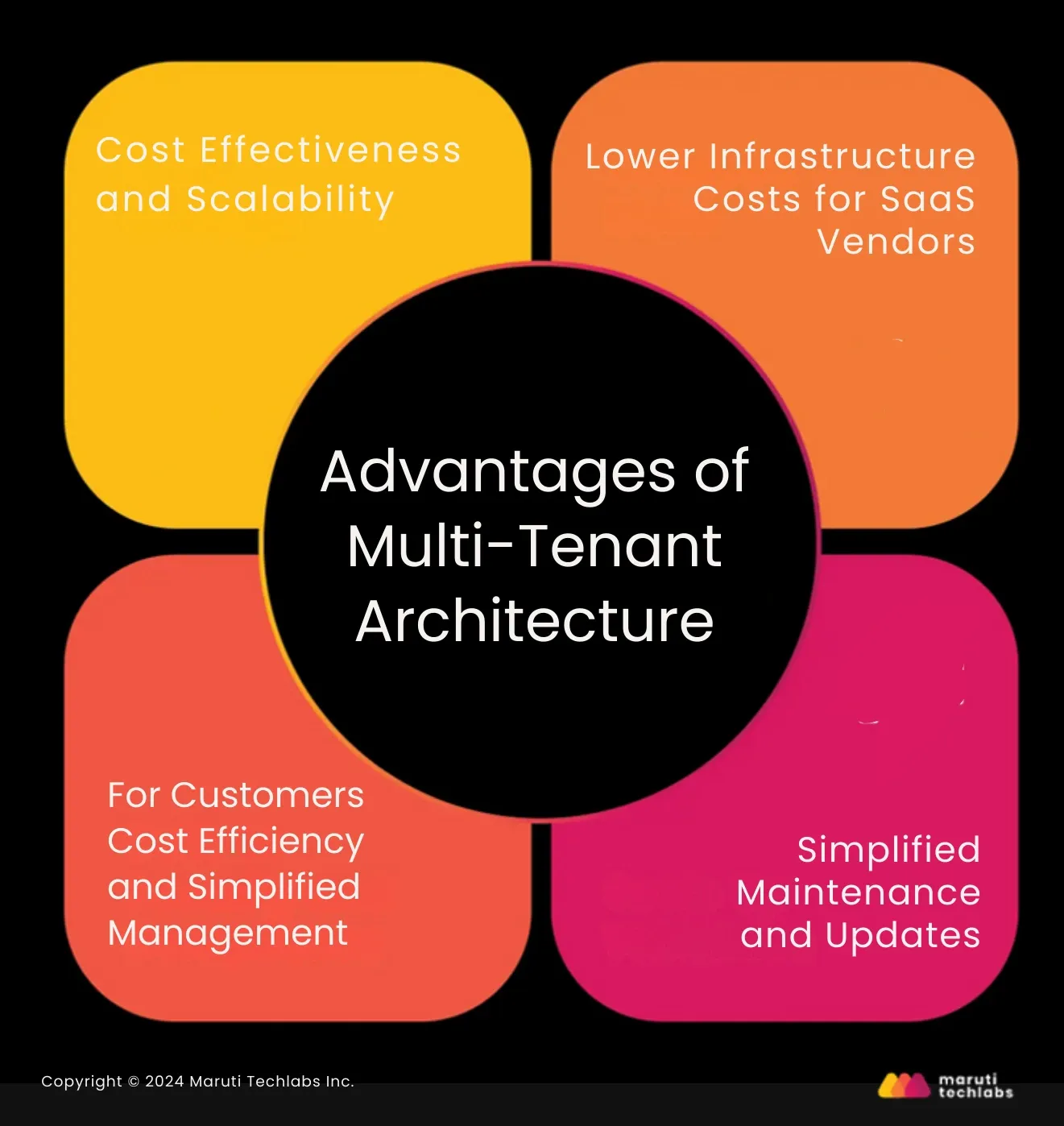
Let’s break down its key advantages:
One of the primary benefits of multi-tenant architecture is its cost efficiency. Most cloud service providers offer a pay-as-you-go model, meaning businesses only pay for the resources they use. This helps companies manage their expenses more efficiently, especially as they grow.
Additionally, scaling is seamless—whether companies need to increase their capacity or downscale, the process is quick and easy without requiring major infrastructure changes.
Multi-tenancy drastically lowers software providers’ operating expenses. SaaS vendors save money on server and hardware costs by maintaining a single platform for several clients because all clients share the same infrastructure. This keeps things profitable while allowing for more competitive pricing.
Multi-tenant architecture simplifies maintenance. Updates can be done at once for all the tenant configurations, minimizing the time they spend with issues and ensuring that they all get the latest, most stable features and security enhancements. This shortened approach also saves the vendors time and guarantees the users a hassle-free experience.
From the customer’s perspective, multi-tenant architecture offers cost savings and ease of management. Businesses can access cutting-edge software without worrying about infrastructure, allowing them to concentrate on core operations. With containerized services supporting this architecture, managing multiple users becomes even more efficient, enabling businesses to achieve more with fewer resources.
While the benefits are clear, it’s also essential to consider the potential downsides of multi-tenant architecture. Let’s explore the challenges and how they impact businesses.
Multi-tenant architecture has its share of benefits, but it’s important to consider the challenges it can pose.
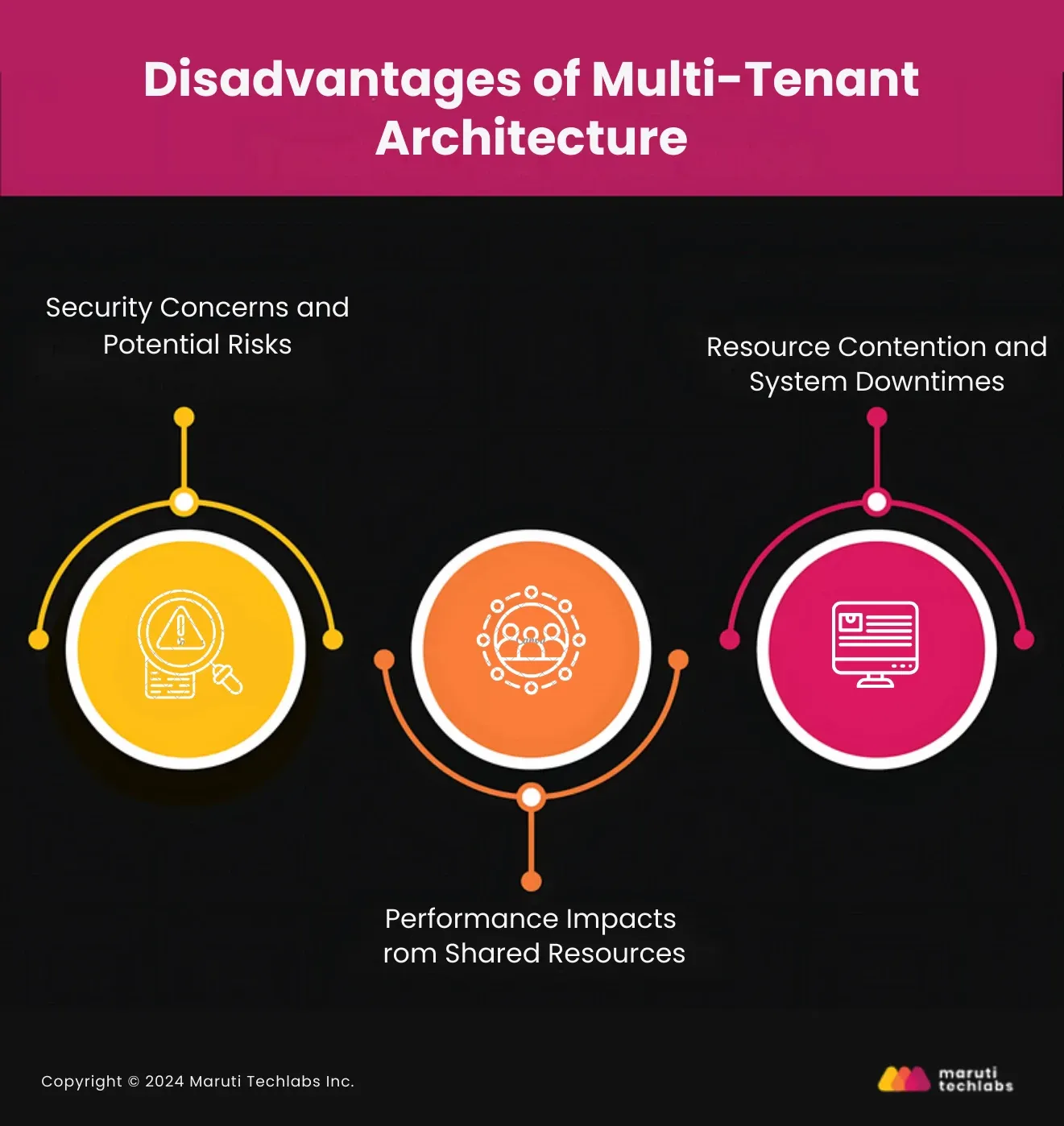
Let’s explore some key disadvantages and how they might affect your business.
Although service providers implement strong security measures, there’s always a risk when sharing hardware. If one tenant's security is compromised, data breaches or accidental data exposure can occur. These concerns could outweigh the benefits for businesses handling highly sensitive information, such as financial institutions or healthcare providers.
An example might be a startup in the fintech space. If another tenant faces a security breach, there’s a chance that vulnerabilities could extend to your data, leading to unintentional exposure.
In a multi-tenant architecture, performance issues can arise when many tenants use the same resources simultaneously. If one business on the platform uses more computing power, your operations might slow down, especially during peak usage times. This is often called the “noisy neighbor” problem, where other users affect your system’s performance.
Consider a business that engages in time-sensitive activities, such as online sales, where a decline in performance could result in lost revenue or irate clients.
Since resources are shared, resource contention can occur, causing delays and downtime. Even the best cloud providers can face unexpected outages, affecting multiple tenants. For example, if a startup relies on cloud-based software for daily operations, a sudden downtime could freeze all activities, leading to revenue loss and disrupted services. System downtimes are particularly challenging for industries like logistics or e-commerce, where a minute of downtime can lead to significant setbacks.
To better understand resource contention and downtimes, let’s compare multi-tenant and single-tenant architectures in performance, customization, and control.
Choosing between multi-tenant and single-tenant architectures depends on cost, security, and scalability. Here's how they compare:
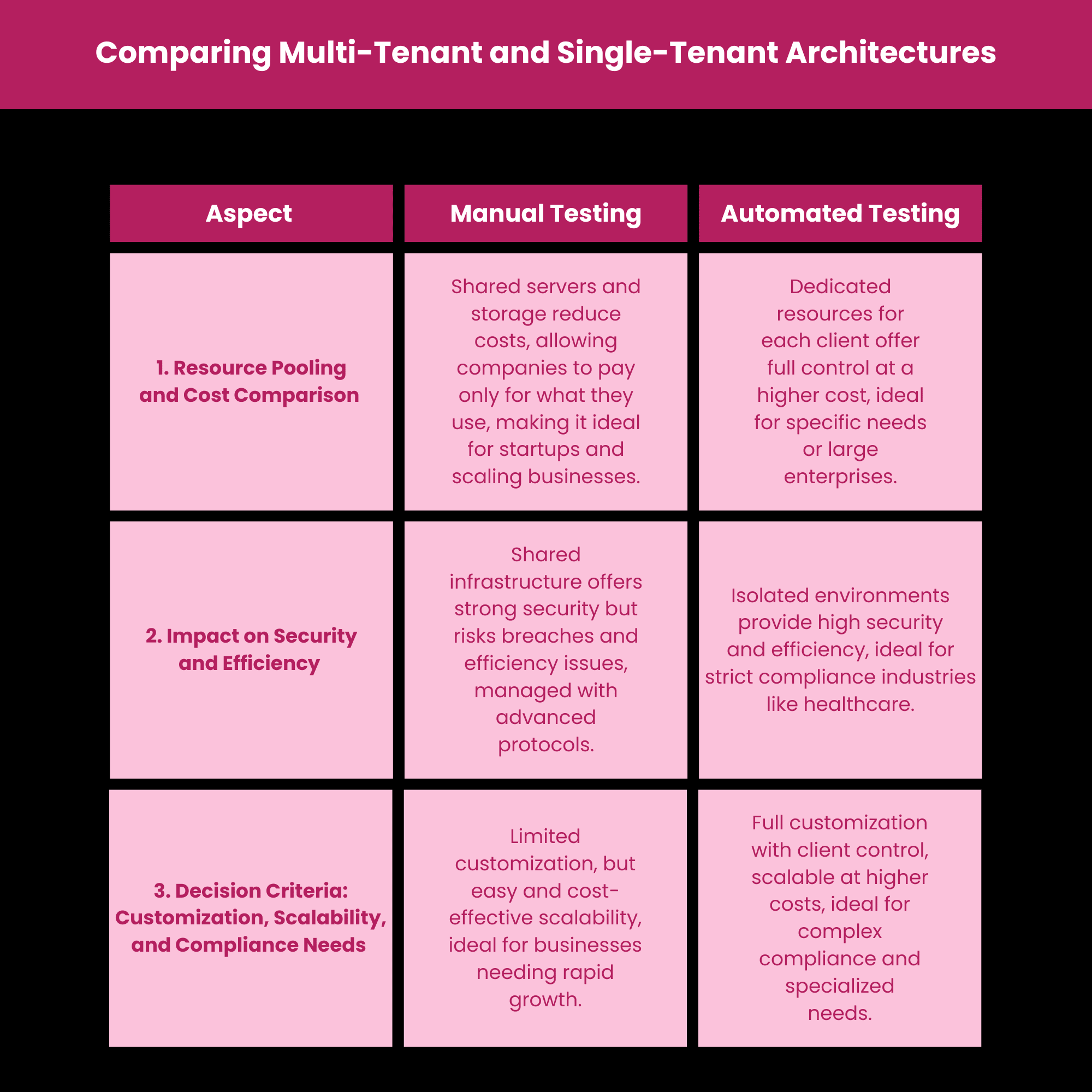
While both architectures offer unique benefits, they also bring challenges that businesses must navigate. Let’s examine these challenges more closely.
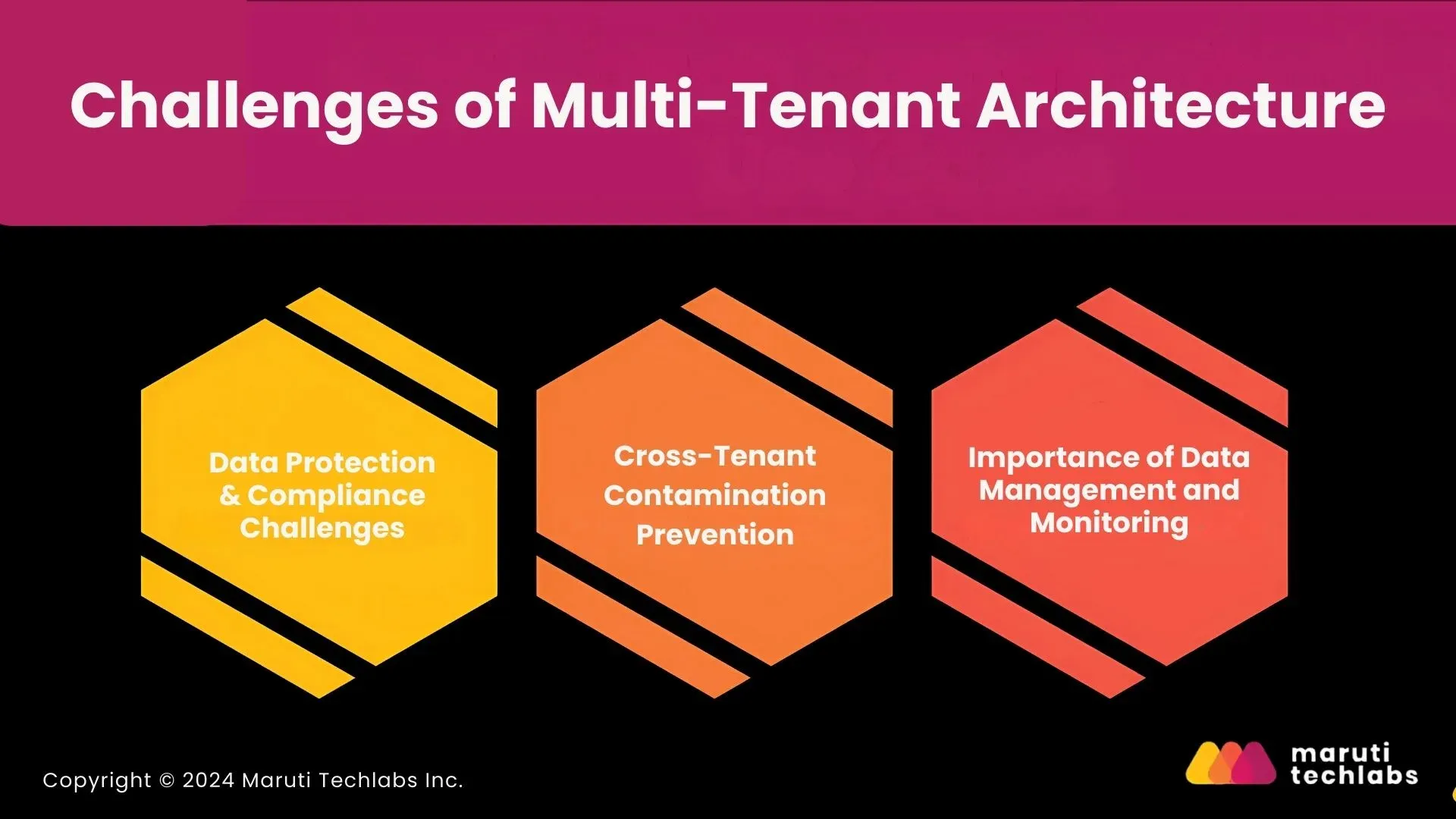
While multi-tenant architecture offers numerous benefits, it presents certain challenges that businesses must manage carefully. Here’s a breakdown of the key challenges to consider:
Maintaining regulatory compliance in a multi-tenant design can be challenging because of the shared infrastructure. The difficulty of adhering to several compliance standards is increased by the possibility that each tenant operates under a distinct set of data protection regulations, such as GDPR or HIPAA.
To remain compliant, businesses that handle sensitive data, such as those in the healthcare industry, must ensure their service provider has strong security measures and auditing capabilities. If you don’t, you risk breaking the law and facing penalties, lost data, and eroded customer confidence.
In multi-tenant architecture, a major challenge is preventing cross-tenant contamination, where one tenant’s data may unintentionally be exposed to another due to vulnerabilities like misconfigurations or software bugs. Even with logical separation, shared environments can still be at risk.
For example, a startup handling financial data could accidentally gain access to another tenant’s information due to errors in the platform’s data partitioning. To mitigate this risk, service providers must enforce robust encryption and isolation protocols to ensure data remains secure and completely separated from other tenants.
Effective data management and monitoring are essential for maintaining the integrity of a multi-tenant system. Real-time monitoring helps track resource usage, performance, and potential risks. Without it, issues like resource hogging or system bottlenecks can go unnoticed, affecting performance. Advanced monitoring tools ensure businesses’ multi-tenant environment stays secure, efficient, and compliant.
To see how these principles work in real-world scenarios, let’s explore some practical implementations and use cases of multi-tenant architecture.
Use this framework to check if multi-tenant architecture supports your goals in cost, growth, safety, and ease of delivery.
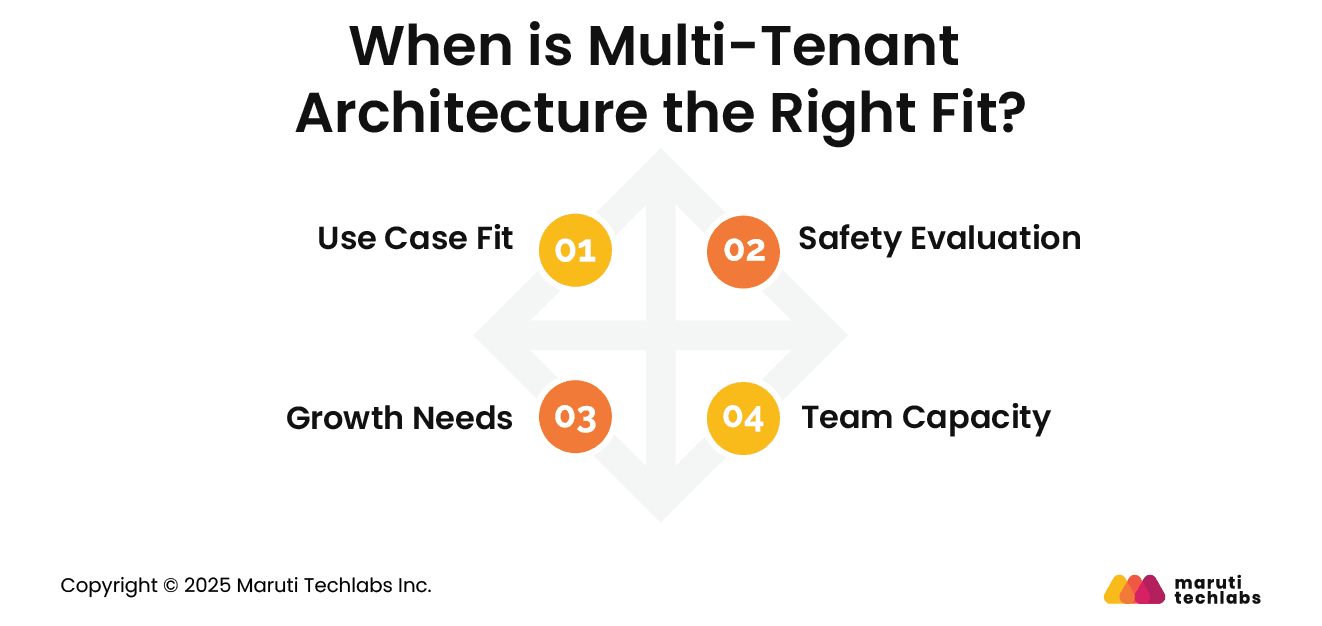
Multi-tenancy works well when you serve many small or medium-sized groups with similar tasks. It supports products focused on cost control, common workflows, and shared features. It suits teams that need some customization but do not want separate systems for every group. It helps deliver stable service to a broad customer base.
If your data rules require moderate separation, multi-tenant models using separate schemas or separate databases can meet these needs. This approach supports oversight and controlled access. Review expected audits, data handling rules, and the level of separation each group needs before choosing.
Multi-tenancy supports fast growth and dynamic entry of new groups. It helps teams scale without new setups or complex delivery paths. If you expect rising demand or expansion across regions, this model offers a clear, straightforward way to grow.
Teams with small support groups benefit from one shared environment. A single delivery path reduces setup effort and limits manual work. This keeps the product stable and lets teams spend more time on development rather than on system maintenance.
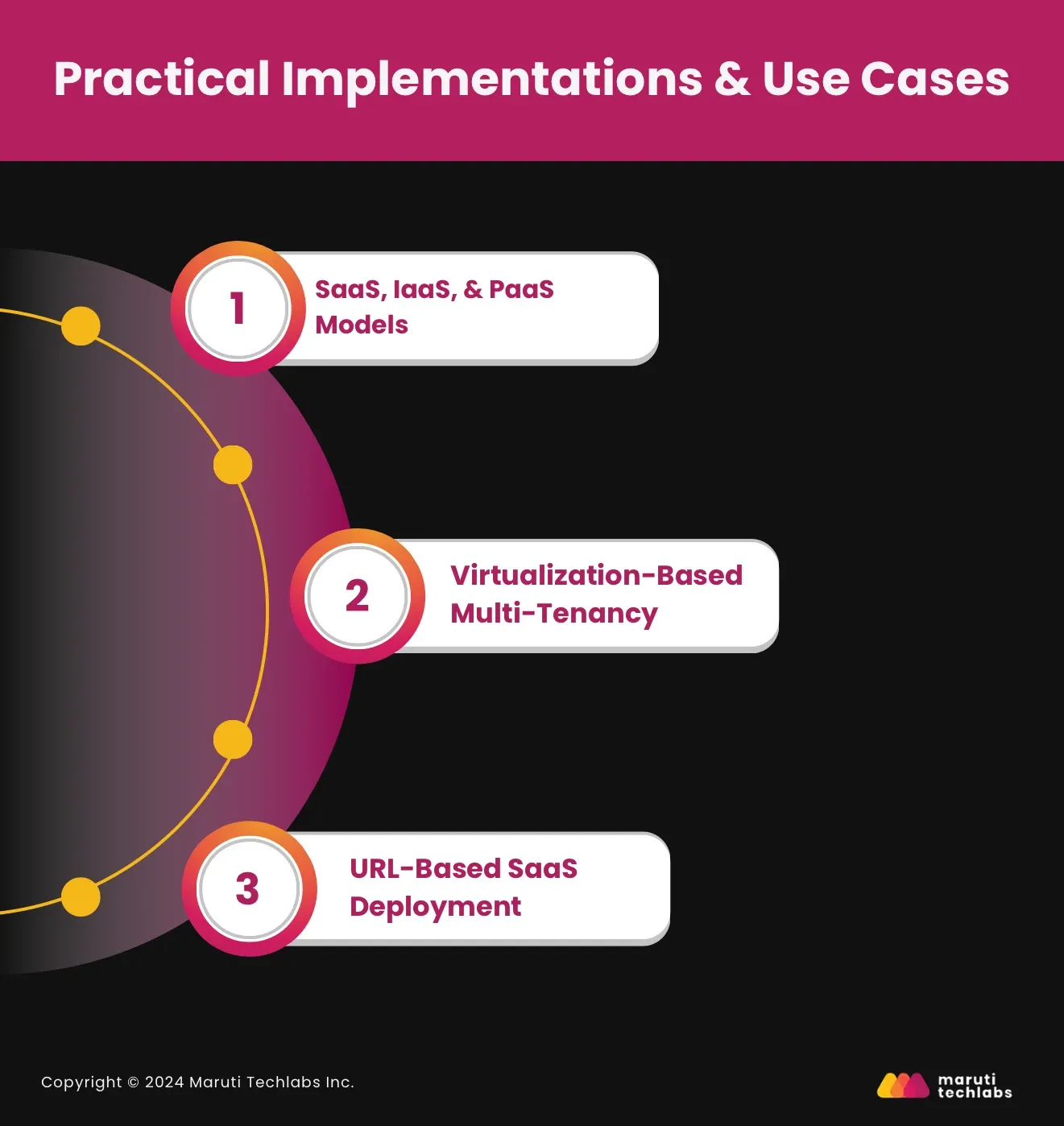
Multi-tenant architecture transforms how businesses utilize cloud services, providing scalable and cost-effective solutions. Below are some practical ways it’s implemented across different industries.
Multi-tenant architecture underpins cloud services like SaaS, IaaS, and PaaS, enabling multiple users to share resources without needing separate environments. For example, SaaS platforms like Microsoft 365 allow businesses to use shared infrastructure while keeping data isolated, making it efficient and secure.
With virtualization, a single physical server can house several tenants, each with its own separate environment. Businesses wishing to grow without making large infrastructure investments frequently employ this strategy.
With URL-based multi-tenancy, tenants can access the same application using different URLs, providing a personalized back-end system experience while sharing resources. Web hosting platforms often use this, allowing users to manage personalized services without additional infrastructure costs.
Using multi-tenant architecture, businesses can optimize resources, scale efficiently, and maintain secure, customized environments, making it a practical solution for today’s demands.
Multi-tenant architecture is now the foundation by which cloud-based services operate as they continue to drive effectiveness and innovation in many industries across the globe. We highlighted its uses later in this paper, including virtualization-based multi-tenancy, URL-based, SaaS, IaaS, and PaaS. Other advantages have also been discussed, including saving, flexibility, and modularity.
However, it has disadvantages, such as cross-contamination of tenants, regulation and compliance issues, and data privacy.
Looking ahead, the future of multi-tenant architecture is promising. With the increasing demand for scalable cloud solutions, businesses will continue to adopt multi-tenancy to enhance their digital operations. However, finding the right balance between its benefits and addressing the challenges will be crucial for successful implementation.
For businesses seeking to streamline their operations and harness the power of multi-tenant architecture, Maruti Techlabs offers tailored solutions to help them achieve their strategic goals. We ensure scalability and efficiency and tackle compliance and security challenges, giving them a reliable partner in their digital transformation journey.
Ready to optimize your operations and scale efficiently? Get in touch with us to find out how our solutions can support the success of your business in a multi-tenant setting.
The multi-tenant architecture allows businesses to access shared resources, significantly reducing costs while offering scalability. This model is ideal for companies looking to grow without heavy upfront investments in infrastructure.
Yes, data security is a priority in multi-tenant environments. Service providers implement strict isolation protocols, encryption, and security measures to keep your data separate from other tenants. However, it’s important to choose a provider that offers robust security controls.
Absolutely. Scalability is one of the most significant advantages of multi-tenant architecture. As your company grows, you can quickly extend your resource usage without requiring large infrastructure adjustments, making it an excellent solution for dynamic organizations.
While this can happen, many providers use advanced monitoring and resource management tools to prevent such issues. Known as the “noisy neighbor” problem, this risk is minimized by ensuring balanced resource allocation across tenants.
Yes, but it requires a provider that offers compliance support tailored to your industry. If your company needs to follow laws like GDPR or HIPAA, be sure the service provider has the appropriate frameworks for compliance, audits, and security measures.


